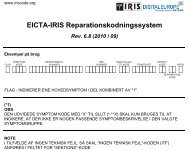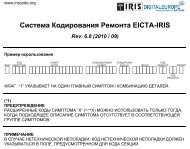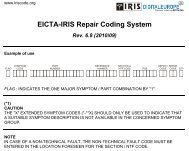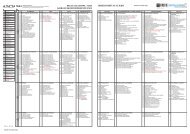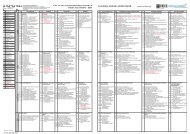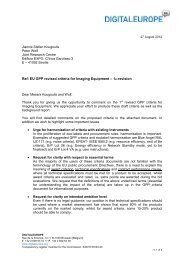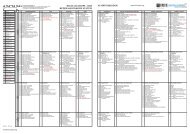Standardized DVB-T2 RF specifications - DigitalEurope
Standardized DVB-T2 RF specifications - DigitalEurope
Standardized DVB-T2 RF specifications - DigitalEurope
You also want an ePaper? Increase the reach of your titles
YUMPU automatically turns print PDFs into web optimized ePapers that Google loves.
All single PLP modes use HEM (High Efficiency) input stage mode. There is no null packet<br />
deletion, in-band signaling, L1 repetition or auxiliary streams. In order to comply with v1.2.1<br />
of the <strong>DVB</strong>-<strong>T2</strong> specification, ISSY should be used in all but the simplest of modes and so the<br />
use of ISSY is explicitly indicated in this document where it is required. Network operators<br />
should be aware that some signal configurations allowed by version 1.1.1 but prohibited by<br />
version 1.2.1 might not be correctly received and decoded by receivers designed to the later<br />
versions. It is therefore recommended that only parameter combinations permitted by version<br />
1.2.1 and later be used. The L1 signaling may however be transmitted according to version<br />
1.1.1.<br />
To reduce receiver testing times, modes 1-4 in Table 1 are only tested for basic AWGN and<br />
0dB echo C/N, and mode 4 is additionally used for co-channel ATV interference testing.<br />
Modes 5-9 represent more commonly used SFN and MFN modes and are specified with all<br />
the performance tests.<br />
2- <strong>RF</strong> FREQUENCIES<br />
This specification covers operation in VHF band III (7MHz channel bandwidth) and/or UHF<br />
bands IV and V (8MHz channel bandwidth). Receivers should be able to operate with<br />
transmission network frequency errors of up to +/-50 KHz, and channel bandwidths of 7<br />
and/or 8MHz.<br />
3- FAILURE POINT CRITERIA<br />
Due to the sharp “cliff-edge” BER characteristic of LDPC decoding, BER measurements are<br />
very time consuming to perform for <strong>DVB</strong>-<strong>T2</strong> measurements, but picture failure<br />
measurements are easier to make than for <strong>DVB</strong>-T. For this reason, two different picture<br />
failure point criteria are defined for different tests:<br />
1. Picture failure point1 (PFP1), defined as the minimum C/N or C/I value when two out<br />
of three 10-second periods are free from picture artefacts.<br />
2. Picture failure point2 (PFP2), defined as the minimum C/N or C/I value when two out<br />
of three 20-second periods are free from picture artefacts. This reduces the<br />
probability of incorrect results when testing <strong>DVB</strong>-<strong>T2</strong> impulse noise immunity for<br />
patterns 7-12 which have a long burst repetition period of 1000 ms.<br />
4- MINIMUM RECEIVER SIGNAL INPUT LEVELS<br />
The receiver should have a noise figure equal or better than 7 dB.<br />
The required minimum input signal levels (P min) for PFP1 are:<br />
P min = -98.1 dBm + C/N [dB ] [for 8 MHz modes 1-3, 7-9 ]<br />
P min = -98.2 dBm + C/N [dB ] [for 8 MHz modes 4-5 ]<br />
P min = -98.7 dBm + C/N [dB ] [for 7 MHz mode 6]<br />
where C/N is specified in Table 2<br />
>>3 of 27



